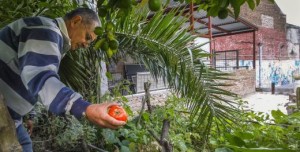By Ivonne Jeannot Laens
Global Press Institute
As the world celebrates Earth Day, urban gardeners take advantage of limited spaces in Buenos Aires to grow and exchange their own vegetables rather than buying them. One urban gardener has tallied 1,500 fruit trees in the city from which many people, including the homeless, can eat for free. The growing movement aims to combat hunger and consumerism while promoting the physical and emotional benefits of gardening.
BUENOS AIRES, ARGENTINA – Every time Ludmila Nahir Medina, 23, leaves her house, she carries a pencil and paper to tally the fruit trees on the streets of Buenos Aires, Argentina’s capital. So far, she has recorded 1,500 trees from which people can eat for free.

“The city gives us flavors,” says Medina, who speaks so fast that her words intertwine as if to keep up with the rapid pace of her thoughts and ideas.
But people do not take advantage of the free fruit, Medina says. So she is building a detailed record of all the fruit trees in the city. The idea began in 2011, when she discovered a tree full of mandarins.
“I imagined that abundance of one tree multiplied by all the trees,” Medina says. “And I wondered how it could be that so much is left over and there are people who do not have anything to eat. It cannot be wasted. It is something logical.”
After the mandarins, she found avocados, lemons, blackberries, medlars, plums, peaches, grapefruit, mandarins, walnuts, bananas and kumquats freely growing in the city. She distributed part of what she collected to the homeless.
But there was more fruit than she could collect, so she began a register. She then launched a Facebook page in June 2012 to share the information with local residents so that they could eat the fruit before it fell and rotted.
The Facebook page, called “La ciudad nos regala sabores,” includes a detailed register of the city’s fruit trees and photos to help people distinguish among them. Moreover, anyone who sees a new tree can contribute this data to Medina’s register.
Full of ideas and ambitions, Medina says her dream is to teach homeless people how to grow their own food in the city. In the meantime, she teaches elderly residents at a nursing home the art of achieving happiness through working the land.
At home, she cultivates an array of vegetables on her terrace, her favorite spot in her house. In this respect, she is part of a movement of urban gardeners that is slowly gaining visibility in the city. In addition to connecting with the earth by growing their own produce, they are abandoning the need to buy fruits and vegetables at produce markets or grocery stores.
In a city of cement, a movement of urban gardeners in Buenos Aires is taking advantage of their minimal spaces to cultivate and trade their own fruits and vegetables rather than buying them. They aim to extend this trend to erode the prevailing consumerist culture that attaches value only to what is bought and sold. Rather, they encourage people to seek happiness and health benefits from working the earth. Others plan to teach homeless people how to garden in order to sustain themselves.
Buenos Aires has a population of 2.89 million, according to the 2010 national census. An additional 3.2 million people flock to the city daily for work, according to the Ministerio de Ambiente y Espacio Público, the city’s Ministry of Environment and Public Space. During peak hours, the city looks like a large anthill, with packed subway cars, crowded buses and congested highways.
Further encroaching on open public space, construction in the city has boomed during the past decade. The volume of constructed meters increased by more than 8 percent from 2001 to 2010, according to a local media report based on data from the Ministerio de Desarrollo Social, the city’s Ministry of Social Development.
In response, residents have been organizing protests for almost a decade to demand the conservation of green space. Meanwhile, as the globe celebrates Earth Day today, a growing movement of urban gardeners is encouraging people to take advantage of the space they do have.
Antonio Urdiales Cano, a permaculture expert, has been teaching techniques on how to produce food in small urban spaces for 20 years. The number of people who take his courses has increased in recent years, he says. They are looking for a lifestyle change.
“Many people who approach me do so saying that they need a change of life,” he says. “Various people express their desire to live in the countryside, but very few realize it, and they stay in the city, but producing their food.”
Urdiales Cano emphasizes that it is not necessary to have large, green, sunny spaces to cultivate food. He teaches people secrets on how to take advantage of the smallest of spaces in the city.
“If someone approaches me and tells me that they want to cultivate vegetables in their apartment, I ask them how many meters of free wall space they have,” Urdiales Cano says. “On the walls, it is possible to cultivate peas and beans, for example.”
He also encourages people to take advantage of the centimeters of earth surrounding trees on the sidewalks. There, they can plant certain species that adapt well to this environment.
“It is enough to make a hole about 30 centimeters in diameter and 30 centimeters in depth on the side of the tree,” he says. “There, you put fresh garbage, like fruit peels, and you throw squash seeds. Squash loves trash, and in a short time, it grows with enormous leaves.”
City residents fortunate enough to have a terrace, patio or garden can assemble little vegetable gardens in the earth or wooden boxes.
Carlos García has been cultivating his garden for six years, growing an endless list of fruits and vegetables, including tomatoes, red peppers, bell peppers, eggplant, string beans, squash, arugula and grapes. In a small garden as well as on his terrace, he produces up to 30 percent of what he and his wife eat.
“Once, we spent the whole year eating vegetables without buying them, thanks to an exchange we did with the grocer in the neighborhood,” he says. “We gave him grapes, and he gave us what we needed.”
In the neighborhood of Caballito, there is an urban garden collective where neighbors can take homemade compost and exchange it for vegetables produced in the garden.
Called Huerta El Caskote, the garden is located in Club Premier, a community center founded by neighborhood residents. The outdoor garden is about 100 square meters and produces lemons, medlars, peaches, mint, squash, tomatoes, pumpkins, corn and carrots, among other items.
Fernando Cabrera, coordinator of institutional activities for Club Premier, says this exchange attracts locals to join the project. Many neighbors who bring compost end up volunteering to tend the garden.
“When we decided to make the garden, we thought it was something that could unite the people,” he says. “The people who participate leave renewed, because it is voluntary.”
Urdiales Cano notes that growing your own food has the added benefit of connecting participants with like-minded people.
“In addition to being able to add something healthy to your diet, this serves to connect you with people who are on the same page,” he says.
García says there should be more people on the same page as he is. During the past, people used to plant fruit trees on properties with gardens, he says. But now, when a young couple buys a house with a garden, they choose to remove the fruit trees because they are not fashionable.
“More culture of making vegetable gardens and knowing how to appreciate these plants is lacking,” García says. “We have to begin to teach in schools how to cultivate the earth.”
For García, the main problem is that people in cities feel as if everything has to occur through money.
“It is a cultural problem,” he says. “If you do not buy it, it is not useful.”
Medina agrees that members of the consumerist society reject what is free.
“There are people who are embarrassed to eat from the fruit trees in the street,” she says. “It seems that if something is free, they are embarrassed to grab it.”
Urdiales Cano says that many people have accepted a model of happiness based on investment and consumption.
“The model of happiness that they sell us says that happiness is in having things,” he says. “I say happiness is in doing things. People seek happiness with what they do, not with what they have. And the work of cultivating produces happiness.”
Medina says that gardening also has a therapeutic purpose. The nursing home residents who take her gardening courses have made important advances in their health.
“I remember once a woman who was in a wheelchair,” Medina says. “She was working in the vegetable garden. Suddenly, when I turned around, I saw that she had stood up to move something that was far.”
Medina says urban gardening can also help alleviate hunger for the homeless.
Some 3.7 million people live on less than $5 a day in Argentina, according to the World Bank.
Therefore, Medina and a group of 10 other people are looking for a public or private space where they can teach homeless people how to cultivate the land.
“For that, we need money or that someone gives us a place,” Medina says. “But the moment will arrive.”
For Medina, happiness lies in taking advantage of what the earth gives and redistributing the excess so that no one goes hungry.
Interviews were translated from Spanish.
Ivonne Jeannot Laens is country editor at the Argentina News Desk of the Global Press Institute. The story was originally published by Global Press Institute. (c) Global Press Institute 2013.




